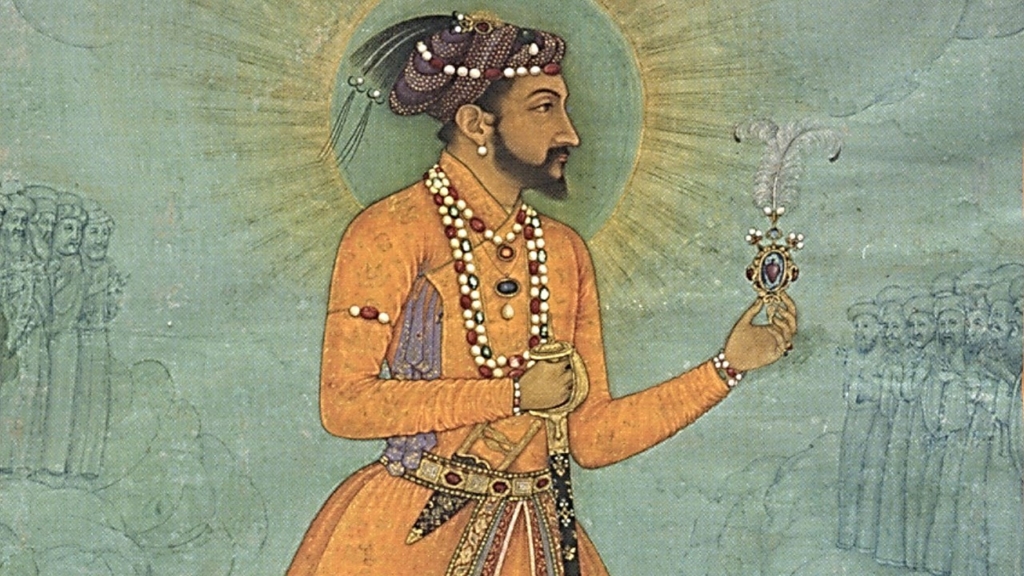Dawn, The Review, sometime in September 2000
 If ever there was a man who lived by the dictates of mind completely ignoring the voice of his heart, it was the Mughal emperor Shahjahan. Ironically, he is best remembered as the lover who built the famous Taj Mahal for his sweetheart.
If ever there was a man who lived by the dictates of mind completely ignoring the voice of his heart, it was the Mughal emperor Shahjahan. Ironically, he is best remembered as the lover who built the famous Taj Mahal for his sweetheart.
Shahjahan’s life is an interesting case study in how lust for power works upon the human mind and how it affects the soul of its possessor. This human drama is comparable to Macbeth in many ways.
When he was born (5 January 1592) his grandfather, the Emperor Akbar, became so delighted that the newborn was named Khurram, or ‘Happy,’ in Persian. Khurram’s horoscope depicted a conjunction of mighty stars, such as had only been noted at the birth of Amir Taimur (Tamerlane). Consequently, Khurram grew up with a sense of destiny and became a child prodigy. When Akbar considered the possibility of removing Salim (Khurram’s father, later Emperor Jahangir) from the line of succession and instead giving his empire to Khurram’s stepbrother Khusro, the thirteen-year-old Khurram was one of the most successful advocates of his father before Akbar.
In the Mughal tradition, the ablest son of a king inherited his throne but the first-born was naturally given a preference. Khurram was third among his brothers so he had to excel himself well in order to become a king. The pressures on this extraordinary child soon taught him to trust no one except his own brilliant mind. His loving grandfather was a heretic, and father a hopeless alcoholic always groping for emotional support. Khurram’s mother was a Hindu, and this might have caused some emotional complication for the young child who was being tutored by orthodox teachers. Religion soon became a political identity for him, though probably nothing more than that. He never developed a liking for alcohol, although it was like a family drink among the Mughals. He also grew a beard unlike his father and grandfather, and later he made it known that he had never missed a prayer in his life. His severe treatment of Hindus in the later life may be credited to some unknown remorse over being born of a Hindu woman.
As Jahangir ascended the throne in 1605 his emotional dependence on Khurram kept growing until it seemed as if the father was behaving like a spoilt son. ‘My son Khurram has grown up now,’ Jahangir records an astonishing anecdote in his autobiography. ‘But he has never tasted wine so far. Now I asked him, Baba, you are now twenty-four years old, and by the grace of God you are father of children. Isn’t it high time you should become familiar with this pleasure too?’ Jahangir goes on to record that Khurram was still reluctant but upon his father’s insistence he took a few sips. How immature and stupid his father must have appeared to Khurram goes unrecorded in history but it isn’t difficult to understand that the son had probably outgrown his father long ago.
The only streak of love in Khurram’s life was Arjumand, later known as Mumtaz Mahal. Khurram married her in 1612, when he was a little over twenty, and instantly fell in love. Sadly, love was one lesson he could never learn.
When people fall in love, they are either elevated to a new understanding of their own existence, or they make a mockery of what they consider love. Khurram didn’t have the capacity to see human beings as individuals in their own right — something his father, despite his many weaknesses, could have taught him. Individuals, to Khurram, only existed by the virtue of their use for him, and what else could be the use of a loved one except to turn her into an idol and worship her! Khurram’s manner of showering love on someone was to objectify them, guard them, spoil them, and curtail their human growth. Through the nineteen years of their marriage, Arjumand remained perpetually pregnant, and finally died in 1631 giving birth to her fourteenth child.
By 1617, at the age of twenty-five, Khurram had become the most powerful man in the empire of Jahangir. He had conquered vast territories in South India and was hailed as the champion of Islam by the puritans who were praying for a reversal of Akbar’s liberalism. Khurram also received the title of ‘Shahjahan’ by the emperor and also the rare honour of getting a chair in the court (only the emperor had the privilege to be seated in a Mughal court while the princes and the courtiers were obliged to stand in attendance). To secure his position further, Shahjahan poisoned (or strangled) his eldest brother Khusro.
When he finally came to the throne in 1628, Shahjahan executed nearly all his male relatives, including his nephew Dawar Shah, who had in a way been helpful to him. In the eyes of his contemporaries it was a well-intentioned move by a peace-loving king. Each previous generation in the Mughal Dynasty had seen quarrels between claimants to the throne, in which soldiers were killed and civilians attacked and raped. By murdering his own relatives Shahjahan ensured the political stability of his reign, and it turned out that he was correct.
The moral implications, however, were different. Generosity and forgiveness were the hallmarks of the Mughal emperors before Shahjahan. It’s questionable whether a monarch can keep his power by the rule of love, but the earlier Mughals certainly made a good attempt at it. With Shahjahan the cold hand of an administrator replaced the warmth of an emperor’s magnanimous heart.
The thirty-one years of Shahjahan’s reign were a period of peace and tranquility. They were also the days of prosperity. He paid attention to the well being of the ordinary people. Knowing well that the revenue of his empire depended mainly on taxes from agricultural lands, he took special care that the tax collectors should be lenient.
Peace and tranquility also brought stagnancy. Shahjahan was averse to anything that suggested change, and hence the spirit of innovation that was another trademark of the Mughals declined during his reign. The status of women was among the first things to get affected. In the earlier eras, the Mughal women had participated in the events of the lives of their men. With Shahjahan the harem became absolutely separated from the public life. The custom of purdah was taken to an unusual extreme and the women of the royal family were idolized so that many of them had to stay unmarried.
On one occasion when fire broke out in the palace of Prince Shuja, the second son of Shahjahan, the women didn’t come out due to concern for their modesty. When men rescued eventually, they too were careful to arrange proper purdah for each woman before she was pulled out of the burning palace. As many as eighty women met their death in fire that night. This was Shahjahan’s concept of stability and decorum – completely devoid of resilience that copes with emergencies.
Religion, or a fundamentalist interpretation of religion, was the best rationale for Shahjahan’s Cultural Revolution. He abolished the custom of prostration before the king along with several un-Islamic customs dating back to the days of Akbar. But he also identified the glory of Islam with the humiliation of other religions. He forbade the building of temples in his empire and his official historians go on to record that thousands of temples built in defiance to this edict were demolished. On at least two occasions he punished Hindu rebels by forcing their women to embrace Islam and then marrying them off to Muslim men (as recorded by Khafi Khan and other historians.) This was something that could never have been expected from a Mughal king, and probably stemmed back to early childhood complexes of Shahjahan about her Hindu mother.
Two anecdotes give us a very good insight into the character of Shahjahan. Once, as his courtiers were discussing the exploits of Alexander the Great, he pointed out to a rash act of his bravery and said, ‘That was stupidity. A wise man never takes a step which, if reversed, could lead to peril.’
The other anecdote, recorded both in Shahjahan Nameh and Khafi Khan’s history, is Shahjahan’s comment on the reign of Hazrat Ali (Razi Allah Anhuh). While praising his piety, he lamented that the rule of Hazrat Ali was interrupted with revolts and civil wars. ‘He was a Holy man, and never negotiated over matters of religious truth whereas countries cannot be kept peaceful without clever compromises. Even religious affairs sometime require that you overlook one truth for the sake of keeping peace in the land.’
Shahjahan has been called the ‘architect king’, but one needs to look deeper for a similarity between Shahjahan’s chosen art form and his psychology. Well thought out buildings, erected upon a carefully chalked out site, rooted firmly into the ground, cut out form cold stones and finally standing up in immovable solidarity effusing a promise of permanence – if anything could touch that part in Shahjahan where other humans have a heart, it was architecture. His desire for permanence, and his aversion to anything suggesting change is evident from his particular style of architecture. His buildings do not stand out apart from their backgrounds like a proud display of human power. They form a conspicuous bond with their surroundings and appear as if they had always been a part of that place. They don’t challenge the equilibrium, nor provoke the spectator. This difference becomes more obvious if we compare Shahjahan’s buildings with the earlier masterpieces of architecture, such as Fatehpur Sikri.
Another remarkable feature of Shahjahan’s buildings is their impression of uselessness. They are perfect in beauty, and perfection implies no further growth. Shahjahan’s buildings can best be appreciated from a distance. If one thinks of living in them, they appear too cold, perhaps also too elegant, for any human interaction. This again reinforces Shahjahan’s concept of beauty as an object devoid of human growth. He paid the price for his ignorance of love, and it cost him his throne.
Mumtaz Mahal (Arjumand Bano) had asked Shahjahan to promise that he would never marry again, so that there are no stepsons to kill her children. Shahjahan, remembering his own conduct towards his stepbrothers, never remarried, though his harem was always refreshed with new varieties of slave girls. His intense love was then reserved for his son Darashikoh and daughter Jahanara. Dara was announced the heir, but he was rarely allowed to perform any service for the state. It was a custom of the Mughal court that princes were given honorary ranks (mansab) only when they were appointed into service. It is said that when the second prince Shuja was given an appointment, and hence a rank, Dara broke out into tears and left the court crying. Shahjahan was moved to offer a rank to Dara but still didn’t initiate him into service.
The younger princes got seasoned in war, administration and diplomacy while Dara only became a scholar with liberal views and a grand dream of harmony between Islam and Hinduism. But he remained a miserable administrator and a worthless general. This turned into a tragedy when in 1659 Shahjahan became ill and the younger princes, assuming him to dead, came out marching upon Delhi, the city which Shahjahan had made capital instead of Agra. The third son, Aurangzeb, defeated Dara and imprisoned Shahjahan. Proclaiming himself emperor, Aurangzeb executed Dara on the pretext of heresy, along with the youngest brother Murad who was framed for murder. Shuja was forced to runaway into the hostile mountains of Arakan where he met a terrible end.
Shahjahan recovered from illness, but was forced to spend the rest of his life as a prisoner of his son Aurangzeb, who was his father’s match in cunning and shrewdness. Shahjahan lived in the Fort of Agra for seven more years until his death in 1666. Tradition has it that he was kept in a chamber from where he could have a clear view of Taj Mahal, the monument that represented his human side so completely. In the long days of abdication, stripped of all power like King Lear, he must have got a chance to reflect upon his life. He must have spent hours wondering how did his empire come to nothingness though he had never committed a single mistake in his long career, never given in to the temptation of the heart over the logic of the head? If he found any answers he took them with him to grave – next to his beloved wife inside Taj Mahal.
It is said that towards the end of his life Shahjahan requested Aurangzeb to send him some children so that he may teach them as a pastime. ‘The old man hasn’t still forgotten the pleasure of being a sovereign,’ Aurangzeb remarked as he turned down his father’s request. Maybe the arrogant son was mistaken and Shahjahan had learnt some new lessons, quite different from the ones he had taught his sons. Or maybe he just wanted to make a fresh start of his life.
 This article is part of the series “The Great Mughals” : Tamerlane | Babur | Khanzadeh Begum | Humayun | Akbar the Great | Anarkali | Jahangir | Nurjahan | Shahjahan | Mumtaz Mahal | Dara Shikoh | Aurangzeb Alamgir | Muhammad Shah “Rangeela”
This article is part of the series “The Great Mughals” : Tamerlane | Babur | Khanzadeh Begum | Humayun | Akbar the Great | Anarkali | Jahangir | Nurjahan | Shahjahan | Mumtaz Mahal | Dara Shikoh | Aurangzeb Alamgir | Muhammad Shah “Rangeela”
Next in the series: Mumtaz Mahal

Fantastyczny tekst Brawo! szczególnie spodobała mi się szata graficzna twojego bloga 🙂 zapraszam do siebie… http://www.xmc.pl